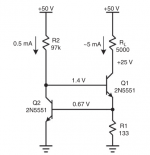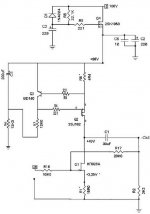How does a Dn2540 as a CCS compare with a discrete CCS like in this preamp would the Dn2540 as a CCS have higher ripple rejection ? And can you run 2 or more DN2540s in parallel ?
I would suppose you need to example dId/dVds which is the effective output impedance of the current source, which is the top left figure on page 4 of the data sheet. The lines look pretty flat which suggest that its going to behave at least at DC as a very good current source. The thing to compare this to would be the Early voltage of a BJT which would determine the slope of dIc/dVce.
For dynamic characteristics one would probably examine the source-drain capacitance, which is COSS or 12 to 30 pF. This will effectively decrease the output impedance of the current source with frequency. Many small signal BJTs have capacitances of a similar magnitude.
Of course, one can use more sophisticated current source types such as current mirrors and cascodes to reduce the effect of the Early voltage or MOSFET channel width modulation effects. So a specialized part may not be necessary if one just wants a constant current source. It depends on the required output impedance needed of the current source. I personally avoid overly specialized parts unless they provide a significant advantage, but that is just my preference.
For dynamic characteristics one would probably examine the source-drain capacitance, which is COSS or 12 to 30 pF. This will effectively decrease the output impedance of the current source with frequency. Many small signal BJTs have capacitances of a similar magnitude.
Of course, one can use more sophisticated current source types such as current mirrors and cascodes to reduce the effect of the Early voltage or MOSFET channel width modulation effects. So a specialized part may not be necessary if one just wants a constant current source. It depends on the required output impedance needed of the current source. I personally avoid overly specialized parts unless they provide a significant advantage, but that is just my preference.
How many percent will you allow the CCS to vary, as the internal air temperature inside the amplifier chassis varies across the range from +20C to +50C ? You may have no other choice than to use an RRIO opamp, plus a bandgap derived shunt regulator IC like LM285, plus a low tempco resistor. In addition to your bipolar or MOS transistor.
Bob Cordell's textbook contains a discussion of CCS stiffness (dIout/dVout) and how it can be improved by increasing the voltage dropped across the degeneration resistor. If you're handy with the hybrid pi model of BJT operation at small signal levels, you can even derive Cordell's result with pencil and paper. And by "handy" I mean "very good".
_
Bob Cordell's textbook contains a discussion of CCS stiffness (dIout/dVout) and how it can be improved by increasing the voltage dropped across the degeneration resistor. If you're handy with the hybrid pi model of BJT operation at small signal levels, you can even derive Cordell's result with pencil and paper. And by "handy" I mean "very good".
_
Last edited:
I am sorry I intended to sent this jpg . If you look at the discrete CCS in this jpg would it likely have more or less ripple rejection than a single Dn2540 at 150 ma. Oh I know a capcode Dn2540 is better than a single but that's not the question.
Attachments
Woody your (Cap multiplier) plus (negative feedback Vbe/R current source) is going to have spectacularly excellent ripple rejection. If you want AWSOMELY UNBELIEVABLY spectacularly excellent ripple rejection, revise the schematic and add one more series copy of (D1 R8 Q4 C3) and accept the loss of another 4 volts of headroom, down to +92V.
But now you're in the regime where ripple rejection is set by PCB layout goodness/badness, rather than circuit topology goodness/badness
But now you're in the regime where ripple rejection is set by PCB layout goodness/badness, rather than circuit topology goodness/badness
- Home
- Amplifiers
- Solid State
- CCS question

